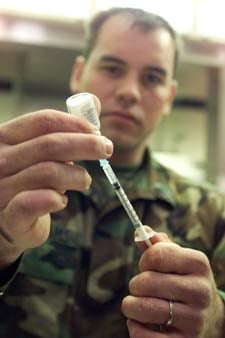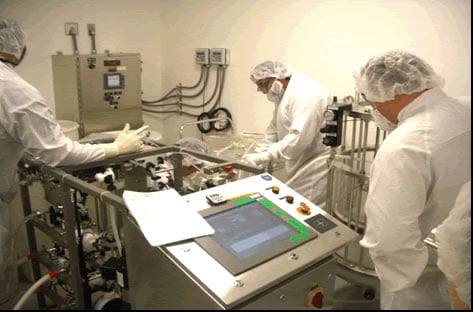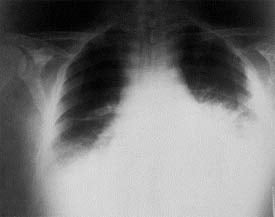 The Nov. 4, 2004 announcement was supposed to be a confidence booster for a nation badly shaken by the 2001 anthrax letter attacks and by revelations that a vaccine was in short supply: The government was ordering 75 million doses of a safer, more efficient anthrax vaccine that would be developed and delivered by 2008.
The Nov. 4, 2004 announcement was supposed to be a confidence booster for a nation badly shaken by the 2001 anthrax letter attacks and by revelations that a vaccine was in short supply: The government was ordering 75 million doses of a safer, more efficient anthrax vaccine that would be developed and delivered by 2008.
But the $877 million contract went to a small California biotech company inexperienced in the drug-approval process, and within two years the effort had failed.
Today, seven years after the anthrax attack that killed five and infected 17, at a time when the shortage was supposed to have been alleviated, the country instead finds itself back at square one -- with a still woefully inadequate supply of the older vaccine and no certainty about when, or even if, a new vaccine might be available.
The existing vaccine, developed in the 1950s, requires six injections over 18 months, plus annual booster shots. The government says it is safe and effective, but it sometimes has unpleasant side effects. The vaccine, known formally as Anthrax Vaccine Adsorbed (AVA), has another problem: a relatively short three-year shelf life.
Development of a second-generation vaccine, requiring fewer injections with fewer side effects, was intended to be the first shining achievement of a $5.6 billion government program called BioShield. Scientists hoped to base the new vaccine on a recombinant form of an anthrax protein called protective antigen. For that reason, it is called recombinant protective antigen (rPA).
But problems developed from the start.
Big pharmaceutical companies didnât bid on the BioShield vaccine contract because they didnât think the government was being realistic about the time and resources needed for such a difficult undertaking. Besides, they could make more money developing blockbuster commercial products like Viagra and Prozac, which people use regularly rather than in an emergency.
 In 2004, the vaccine contract was awarded to VaxGen, a young California biotech company that had never taken a product from discovery to market.
In 2004, the vaccine contract was awarded to VaxGen, a young California biotech company that had never taken a product from discovery to market.
In 2006, the government terminated the contract without making any payments, saying it had lost confidence in VaxGen. A 2007 GAO report found that the governmentâs âoverly aggressiveâ timetable had set up the company for failure.
W. Craig Vanderwagen, the assistant secretary for preparedness and response at the Department of Health and Human Services, calls the BioShield problems âa lesson learned.âBioShield remains in place to buy vaccines and antidotes already approved for the market. But a new agency, the Biomedical Advanced Research and Development Authority (BARDA), was created to manage the development of new biodefense drugs, including rPA.
âI think the assertion is correct that the federal sector did not fully understand what it would takeâ to develop a new anthrax vaccine, Vanderwagen said. âSince â06, a lot of that has been changed. I think our folks over at BARDA are much smarter and are executing this much better. Weâre still on a learning curve, but weâve augmented our staff over there (at BARDA) with a significant number of scientists that have industry experience.â
 Without the new vaccine, the government faced another problem: It hadnât ordered enough of the existing but problematic AVA vaccine as a backup. New contracts were quickly signed, but today the United States has made little progress toward the goal it established after the 2001 anthrax attack. The plan then was to be prepared to protect 25 million people, which meant building a stockpile of 75 million doses of vaccine.
Without the new vaccine, the government faced another problem: It hadnât ordered enough of the existing but problematic AVA vaccine as a backup. New contracts were quickly signed, but today the United States has made little progress toward the goal it established after the 2001 anthrax attack. The plan then was to be prepared to protect 25 million people, which meant building a stockpile of 75 million doses of vaccine.
The current stockpile, however, is less than a third of that number -- somewhat more than 20 million doses, according to Vanderwagen.
The arrival of an rPA vaccine might help eliminate the anthrax vaccine shortage but that wonât happen for at least three years, according to HSSâ timetable. In fact, HHS is only now weighing bids from companies for finishing development of the rPA vaccine, putting the government essentially where it was in 2004, before the VaxGen fiasco. Even the three-year timetable might be overly optimistic: âfive years is probably the more reasonable expectation,â Vanderwagen conceded.
Meanwhile, the shortage of anthrax vaccine has spotlighted a problem in the stockpiling of the existing AVA vaccine.
 Until last year, the Strategic National Stockpile lacked a âfirst in, first outâ system â comparable to a grocery store moving older cartons of milk to the front of the refrigerated display case. The upshot: With vaccine supplies still critically short, some $12 million worth of the vaccine, which could have been used to inoculate troops, instead expired in 2007, and $100 million worth is expected to expire in 2008.
Until last year, the Strategic National Stockpile lacked a âfirst in, first outâ system â comparable to a grocery store moving older cartons of milk to the front of the refrigerated display case. The upshot: With vaccine supplies still critically short, some $12 million worth of the vaccine, which could have been used to inoculate troops, instead expired in 2007, and $100 million worth is expected to expire in 2008.
Because of the vaccine shortage, some of the expired vaccine was kept as a backup in case of a mass emergency. The unintended consequence: 120 sailors aboard the USS Cowpens were accidentally inoculated with expired anthrax vaccine, even though several million unexpired doses were available.
Vanderwagen said the problem was corrected in the last year when the military and civilian stockpiles of anthrax vaccine were merged. Now, doses that might be close to expiration are used to vaccinate military personnel.
âWeâre rotating the vaccines out that have the shorter shelf life . . .which opens up our stockpile for replenishment with new stocks,â he said.
Eliminating the shortage of anthrax vaccine will not be so quick or certain.
While the government has a contract designed to modestly increase the stockpile of AVA vaccine, itâs counting on the arrival of the still-to-be-developed rPA to reach its goal of 75 million doses of anthrax vaccine. That means that even if all goes as planned, the nation will face a shortage of anthrax vaccine until 2011 --10 years after the anthrax letter attacks that rocked the nation.
And what if development of rPA fails, once again?
âIf our rPA production goes down the tubes then weâre going to have to re-evaluate how much weâre going to put into the AVA versus whatever the next generation looks like,â said Vanderwagen. âThose are all decisions that are time and technology contingent.â



